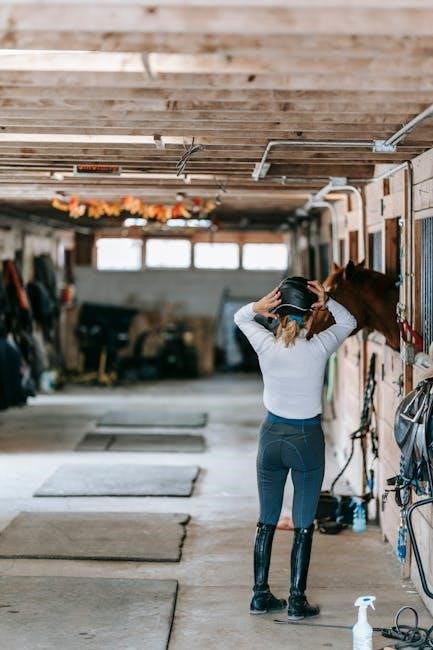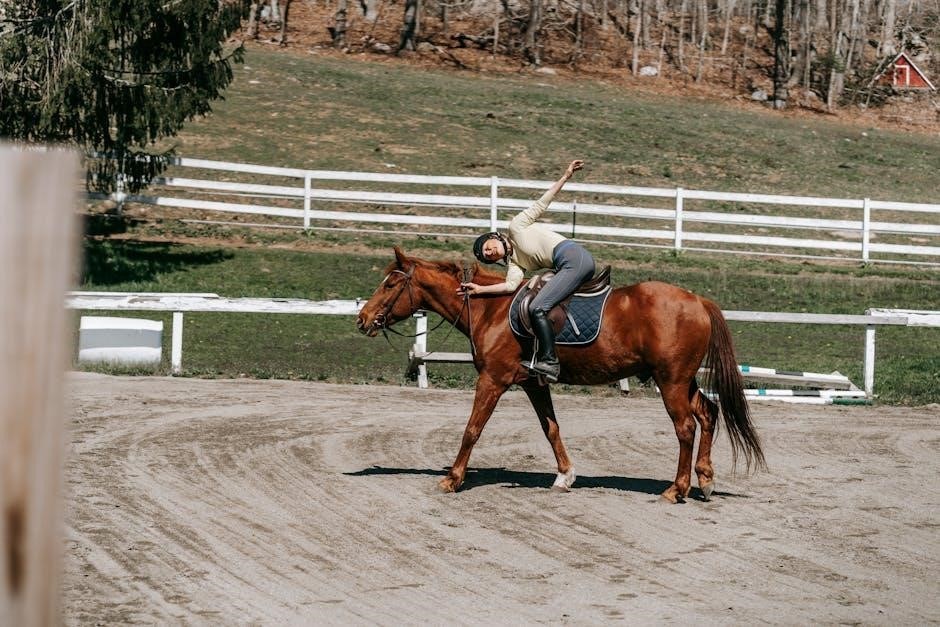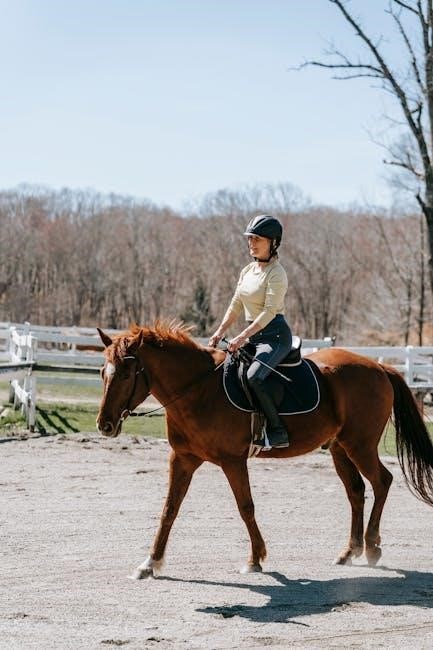horse riding helmet size guide
A properly fitted horse riding helmet is essential for both safety and comfort. This guide provides detailed steps to measure your head, understand size charts, and choose the right helmet size for optimal protection and ease during rides.
Discover how to ensure a secure fit, consider factors like hair styles and head shape, and learn about safety standards to make an informed decision.
Whether you’re a novice or an experienced rider, this guide will help you find the perfect helmet to suit your needs.
It also covers common mistakes to avoid and tips for maintaining your helmet.
With this comprehensive guide, you’ll be confident in selecting a helmet that prioritizes your safety and comfort while riding.
Why Proper Helmet Size Matters for Safety and Comfort
A well-fitting helmet ensures optimal protection by staying securely in place during rides, reducing the risk of head injuries. Proper sizing also enhances comfort, preventing discomfort or pain caused by a helmet that’s too tight or too loose. A helmet that fits correctly provides consistent coverage and support, allowing riders to focus on their performance without distractions.
Additionally, it prevents shifting during maneuvers, offering peace of mind.
A correct fit also accommodates individual factors like head shape and hairstyle, ensuring reliability and confidence while riding.
Proper helmet size is crucial for balancing safety, comfort, and overall riding enjoyment.
How to Measure Your Head for a Horse Riding Helmet
To measure your head, use a soft measuring tape or string around the widest part, about one inch above your eyebrows. Ensure a snug, level fit for accurate sizing.
Using a Measuring Tape for Accurate Head Circumference
To ensure an accurate head circumference, wrap a soft measuring tape around the widest part of your head, about one inch above your eyebrows. Keep the tape level and snug but not too tight. This measurement will help you determine your helmet size using the provided size chart. For the most precise fit, avoid measuring over bulky hairstyles or accessories. Some helmets may also allow for adjustments, so your measurement should align closely with the size range. This step is crucial for both safety and comfort during rides.
Measuring with a String: A Practical Alternative
If you don’t have a measuring tape, use a string to measure your head circumference. Wrap the string snugly around the widest part of your head, just above your eyebrows. Mark where the string overlaps, then lay it flat to measure the length with a ruler. This method provides an accurate measurement to compare with helmet size charts. Keep the string level and avoid pulling it too tight or too loose for the best results. This simple technique ensures a proper fit without special tools.

Understanding Horse Riding Helmet Size Charts
Understanding horse riding helmet size charts is crucial for selecting the right fit. These charts convert head measurements into standardized sizes, ensuring safety and comfort during rides.
By comparing your head circumference to the chart, you can determine the ideal helmet size.
This step is essential for ensuring proper protection and a comfortable riding experience.

Standard Size Charts for Horse Riding Helmets
Standard size charts for horse riding helmets provide a consistent way to match head measurements to helmet sizes.
These charts typically range from extra small to extra large, with specific circumference measurements for each size.
For example, a small helmet might fit a head measuring 21-22 inches, while a medium fits 22-23 inches.
Popular brands like Troxel and KASK offer detailed charts to help riders find their ideal fit.
By referring to these charts, riders can ensure their helmet is both comfortable and secure.
Converting Head Measurements to Helmet Sizes
Once you have your head measurement, refer to the size chart to find the corresponding helmet size.
For example, a 22-inch head circumference might fall into a medium size, while a 23-inch might be a large.
Most charts provide measurements in inches and centimeters for accuracy.
Always consult the manufacturer’s specific size guide, as variations can occur between brands.
This step ensures a proper fit, crucial for both safety and comfort during rides.
Factors That Affect the Fit of Your Horse Riding Helmet
Your hairstyle, head shape, and manufacturer sizing variations can influence the fit of your helmet.
These factors must be considered for optimal comfort and safety.
Hair Styles and Their Impact on Helmet Fit
Hair styles can significantly affect how your riding helmet fits.
For example, braids, ponytails, or loose hair may require adjustments for proper fit.
Measure your head with your typical riding hairstyle to ensure accuracy.
Tight styles like braids can make your head circumference appear smaller, while loose hair may require a slightly larger size.
Always ensure the helmet sits securely, regardless of your hairstyle, for optimal safety and comfort during rides.
Head Shape and Its Role in Choosing the Right Helmet
Your head shape plays a crucial role in selecting a helmet that fits comfortably and securely.
Oval-shaped heads typically fit most helmets, while round or elongated heads may require specific styles.
Some helmets are designed with adjustable features to accommodate different shapes.
Always try on a helmet to ensure it sits evenly and doesn’t shift.
Proper fit ensures safety and comfort, regardless of head shape.
How Manufacturer Sizing Can Vary
Helmet sizing can differ between manufacturers due to varying design standards and fit preferences.
Some brands may run slightly larger or smaller than others, even for the same nominal size.
Always refer to the specific size chart provided by the manufacturer.
Trying the helmet on, if possible, ensures the best fit.
This variation highlights the importance of checking measurements and fit before purchase.

Safety Standards for Horse Riding Helmets
Safety certifications like SEI ASTM F1163-15 and VG1 ensure helmets meet rigorous protection standards.
These certifications guarantee your helmet provides reliable impact protection, crucial for rider safety.
Key Safety Certifications to Look For
When selecting a horse riding helmet, look for certifications like SEI ASTM F1163-15 and VG1, which ensure helmets meet rigorous safety standards. These certifications verify that the helmet provides reliable impact protection and meets specific safety criteria for equestrian activities. ASTM certification is commonly recognized in the U.S., while VG1 is a European standard. Both ensure the helmet can withstand various impacts and protect the rider’s head effectively. Always choose a helmet with these certifications for optimal safety.
Why Certification Matters for Your Protection
Certification ensures your helmet meets strict safety standards, providing proven protection in case of impact. It validates the helmet’s ability to absorb shocks and reduce injury risk. Certified helmets undergo rigorous testing for impact resistance, penetration resistance, and retention strength. This guarantees they can withstand various accident scenarios. Non-certified helmets may fail to offer adequate protection. Always prioritize certified helmets to safeguard your head and ensure peace of mind while riding.
How to Choose the Right Style of Horse Riding Helmet
Selecting the right style involves considering your riding discipline, such as dressage, show jumping, or endurance, and prioritizing features like ventilation, weight, and safety technologies for optimal performance and protection.
Different Disciplines and Their Helmet Requirements
Different equestrian disciplines require specific helmet features. For example, show jumping helmets often have a more robust design, while dressage helmets are sleeker to blend with traditional attire. Endurance riding may prioritize ventilation and lightweight materials, whereas eventing helmets need to meet both jumping and flatwork standards. Each style ensures safety while catering to the unique demands of the discipline, making it crucial to choose a helmet tailored to your riding style for optimal performance and protection.
Features to Consider for Your Riding Needs
When selecting a horse riding helmet, consider features like ventilation for breathability, especially during long rides, and lightweight materials for comfort. MIPS technology enhances safety by reducing rotational impact. A removable visor can shield your eyes from sunlight. Adjustable padding ensures a customizable fit, while a magnetic chin strap simplifies use. Some helmets also offer Bluetooth compatibility for communication. Prioritize features that align with your riding style, discipline, and personal preferences to enhance your overall riding experience.

Adjusting Your Horse Riding Helmet for the Best Fit
Ensure a secure and comfortable fit by adjusting the helmet’s padding and chin strap. Regularly check the fit to maintain optimal safety and comfort while riding.
Ensuring a Secure and Comfortable Fit
To ensure a secure and comfortable fit, start by accurately measuring your head circumference using a soft tape or string. Place the tape just above your eyebrows and ears, keeping it level. Compare this measurement to the size chart provided by the manufacturer to select the correct size. Once the helmet is on, it should sit level on your head, not tilted back or forward, and feel snug but not overly tight. The chin strap should be adjusted to keep the helmet firmly in place, preventing any movement when you shake your head gently. Proper fit is crucial for both safety and comfort, so take the time to ensure your helmet meets these criteria. Additionally, consider your hairstyle, as bulky styles may require a slightly larger size, and remember that fit preferences can vary between riders. Regularly check the fit of your helmet, as hair thickness or padding compression can alter how it sits over time.
By following these steps, you can ensure your helmet provides the protection and comfort you need for enjoyable and safe rides.
How to Make Adjustments for a Perfect Fit
After selecting the right size, fine-tune the fit by adjusting the padding or fit system. Ensure the helmet sits level and snugly around your head; Tighten the chin strap so it’s secure but comfortable. Test the fit by gently moving your head; the helmet should stay in place. If needed, add or remove padding for a personalized fit. Regularly check and adjust the fit to accommodate changes in hairstyle or head shape.
Common Mistakes to Avoid When Buying a Horse Riding Helmet

Avoid rushing the sizing process and ignoring personal fit preferences. Ensure proper measurements and try helmets on if possible to guarantee comfort and safety.
Rushing the Sizing Process
Rushing the sizing process can lead to an ill-fitting helmet, compromising both safety and comfort. Always take the time to measure your head accurately using a tape or string. Compare your measurements to the manufacturer’s size chart. If possible, try the helmet on to ensure a secure and comfortable fit. Different brands may vary slightly in sizing, so don’t assume your usual size will fit. Patience ensures the right fit for optimal protection.
Ignoring Personal Fit Preferences
Ignoring personal fit preferences can lead to discomfort and compromised safety. Every rider’s head shape, hairstyle, and comfort needs are unique. A helmet that fits one person perfectly may not suit another. Always consider your individual preferences when choosing a helmet size and style. Disregarding these factors can result in a helmet that is too tight or too loose, affecting both safety and riding experience. Prioritize your comfort and specific needs for the best fit.

Maintenance and Replacement of Your Horse Riding Helmet
Regular cleaning with mild soap and water is essential for maintaining your horse riding helmet. Replace it after any impact or every five years for safety.
How to Clean and Care for Your Helmet
To maintain your horse riding helmet, clean it with mild soap and water using a soft cloth. Avoid harsh chemicals or abrasive materials that could damage the exterior or interior. Regularly inspect for signs of wear, such as dents or cracks, and ensure the padding is clean and free from sweat buildup. Allow the helmet to air dry after cleaning to prevent moisture accumulation. Always follow the manufacturer’s care instructions for specific materials and ensure proper maintenance to uphold safety and comfort.
Knowing When It’s Time to Replace Your Helmet
Your horse riding helmet should be replaced immediately if it sustains an impact or shows visible damage, such as cracks or dents. Even without obvious damage, helmets should be replaced every 3-5 years, as materials degrade over time. Additionally, if the fit becomes loose or the padding wears out, it’s time for a new helmet. Regular inspections can help ensure your helmet remains safe and effective, protecting you during rides.
Selecting the right horse riding helmet ensures safety, comfort, and confidence. Proper fit, size, and safety standards are crucial. Follow this guide to make an informed decision and enjoy safe, enjoyable rides.
Remember, a well-fitting helmet is your most important protective gear. Always prioritize quality and correct sizing for optimal protection. Happy trails!
Final Tips for Choosing the Right Horse Riding Helmet
Always measure your head accurately using a tape or string, considering your hairstyle. Ensure the helmet meets safety standards like ASTM or SEI. Avoid using helmets designed for other sports. Test the fit in person if possible, and check for certifications. Remember, proper fit ensures safety and comfort. Replace your helmet after a fall or every five years. Prioritize quality and correct sizing for optimal protection during rides.
